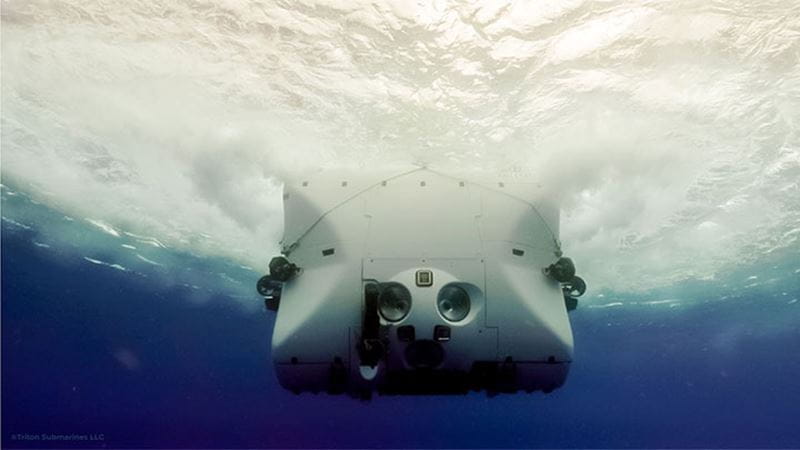Deep Dive

The Five Deeps Expedition, a year-long journey under way since late 2018, launched as the first global ocean journey to send a manned submersible vessel, the Limiting Factor, to the deepest point in each of the world’s five oceans. It is not only exploring places never visited before, but also being used for technical capability verification and scientific mission.
Since the expedition began, it has managed to capture the global imagination. The significance of what the expedition has already achieved rivals man’s first steps on the moon. Every dive conducted during Five Deeps is a first, and the records are stacking up. Besides diving deep into uncharted territory,the expedition has discovered new underwater species.
Victor Vescovo, an American extreme explorer and the initiator and sub pilot of the Five Deeps Expedition project, has had a lifelong passion for exploration. He has reached the highest peak on all seven continents, including Mount Everest, and skied to both the North and South Poles. Upon completion of the Five Deeps Expedition in 2019, Vescovo would be the first person in history to have been to the top of all continents, both poles, and the bottom of all oceans.
Three years of intensive efforts from some of the world’s leading oceanographers, submarine engineers and scientists were necessary to make Vescovo’s historic attempt of the Five Deeps expedition possible. Trelleborg Offshore & Construction played an integral role in the development of the Limiting Factor, providing six buoyancy modules manufactured from Trelleborg’s TG-11500 low-density, ultra-high-performance syntactic foam to specifications from the submersible’s builder, Triton Submarines LLC. The same syntactic foam was also supplied to Triton for use on “landers” deployed with the submersible. These carried many different types of scientific instruments, as well as guidance and positioning equipment.
“The overriding aim of our project was for the submersible to undertake repeated dives several times, to full ocean depth,” says Alan Green, Project Manager, Triton Submarines. “The part that Trelleborg played in that was huge.”
Trelleborg collaborated with Triton Submarines in the groundbreaking project initially through a U.K.-based design house, and then subsequently as a technical partner through the offices in the United States.
“Once the buoyancy modules were manufactured by Trelleborg, they were commercially certified by the international maritime authority DNV-GL,” says Stephen Sloan, Commercial Manager within Trelleborg Offshore & Construction. The testing for the certification took place at the Krylov State Research Centre in St. Petersburg, Russia. This involved extensive, repeated dives following significant material qualification testing and full-scale cyclic pressure testing of the actual modules to 120 percent of full ocean depth, which is over 20,000 psi (pound-force per square inch). “Over 1,000 different tests were conducted on the Trelleborg TG- 1500 syntactic foam under the scrutiny of DNV-GL over a six-month period,” Sloan says.
When the testing was completed, the buoyancy blocks came back from Russia to the U.K. to be finished, and a polyurethane elastomer coating was applied to the blocks. The white Trelleborg buoyancy blocks which made up a sizeable proportion of the overall body of the manned submersible vessel.
“An expedition of this size and scope has never before been attempted,” Sloan says. “The buoyancy has contributed to the success of the mission, and to the recordbreaking achievements now being witnessed with each dive.”
The Five Deeps is as much about science as it is about extreme exploration. The expedition’s scientific program is being led by Dr. Alan Jamieson, a marine biologist at Newcastle University in the U.K. Findings from these extreme depths will be shared with the global academic, oceanographic and environmental communities.
In May 2019, for the fourth time, the Five Deeps Expedition successfully reached the bottom of one of the world’s five oceans. The team completed a mission to go to what is commonly known as the deepest point on planet Earth: the Challenger Deep within the Mariana Trench in the Pacific Ocean.
“The Trelleborg team produced a fantastic product, and that has been truly demonstrated by what has been seen over the past few weeks,” Green says. “It is a stunning achievement, five dives in the Mariana Trench in 10 days. The design, manufacture and engineering capabilities, and the combined efforts of the Trelleborg team, have produced something truly world class.”
For more information, please go to:
https://www.trelleborg.com/en/applied-technologies
This is an article has been reproduced from Trelleborg's T-Time magazine. To download the latest edition, go to: www.trelleborg.com/t-time
Press Service: This article is available in eight languages. Media are welcome to use this article in their own publications. To download the article and pictures in any language go to https://bamboo-contentpartner.com/. If you reproduce information from this release, please give contact details as: www.trelleborg.com.
Images copyright Triton Submarines and the Five Deeps Expedition